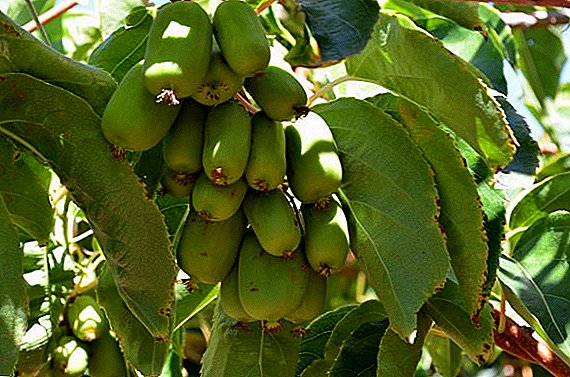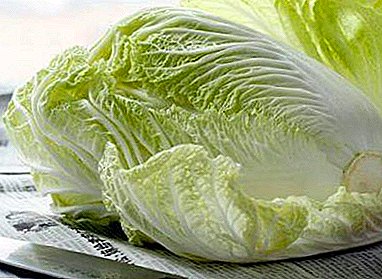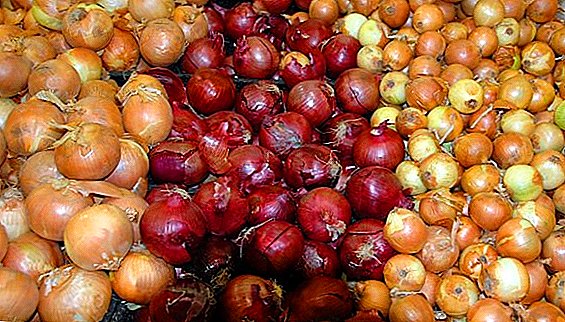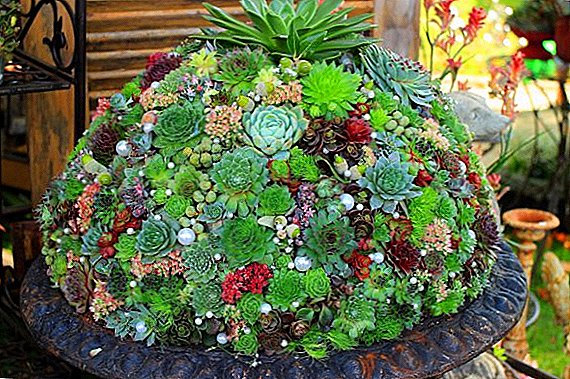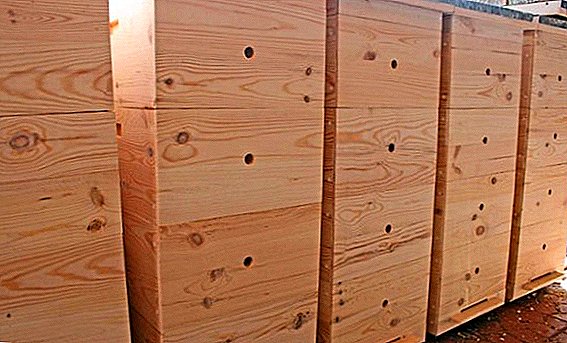 Today, it is not difficult to acquire a ready multihull hive. Such a design can be bought in almost any store specializing in the sale of equipment for beekeeping. But if you want to save money and at the same time realize your creative abilities, then you can make a similar hive with your own hands.
Today, it is not difficult to acquire a ready multihull hive. Such a design can be bought in almost any store specializing in the sale of equipment for beekeeping. But if you want to save money and at the same time realize your creative abilities, then you can make a similar hive with your own hands.
What is needed?
By itself, the design of a multi-body hive is quite simple, so that it can be assembled by a person who has almost no idea about the joinery craft.  The internal structure of the structure includes such elements.:
The internal structure of the structure includes such elements.:
- pillow;
- a lap;
- mesh with strapping;
- lower and upper open entrance;
- honeycombs in which food is sealed, as well as empty cells;
- semi-housing with free space.
The best types of wood are pine, cedar and larch. The thickness of the boards should be at least 35 mm.
Important! When creating a hive, do not use metal structures. Such material as metal can have a negative impact on the general condition and development of the bee family.The optimal frame size of the multi-hive is 435x230 mm. It is best to maximize the apiary imitated the natural habitats of bees.
Usually in the wild, the hollow of a tree, where winged insects make a hive, is about 300 mm in size.  The cover can be made of small ceiling plates. To ensure the reliability of bonding, the elements must be carefully lubricated with glue.
The cover can be made of small ceiling plates. To ensure the reliability of bonding, the elements must be carefully lubricated with glue.
It is better to refrain from using metal nails. For insulation design, you can use small pads sold in the store with goods for beekeeping.
You will be interested to learn how to make a hive Dadan.
Step by step instructions with drawings and sizes
Accurate adherence to these dimensions and the use of quality materials for manufacturing will be the key to creating a strong and reliable design.  The technology of the construction of a multihull hive, as well as other types of hives, has its own characteristics. And they need to be considered in more detail.
The technology of the construction of a multihull hive, as well as other types of hives, has its own characteristics. And they need to be considered in more detail.
Did you know? The progenitor of the modern multicase hive is a frame hive, invented in the mid-nineteenth century by the American beekeeper LL Langstrot. After the entrepreneur A. I. Ruth modified this construction, the hive practically did not undergo serious changes and is now widely used by beekeepers.
Roof
The base of the roof is made of durable boards that provide rigidity to the whole structure. The roof is the only part where metal can be used.  As a rule, the roof is wrapped with sheet metal. The thickness of the roof boards should be 25 mm. This is the optimum thickness, which, if necessary, will allow the use of a warming pad.
As a rule, the roof is wrapped with sheet metal. The thickness of the roof boards should be 25 mm. This is the optimum thickness, which, if necessary, will allow the use of a warming pad.
The roof is installed tightly so that there are no gaps between it and the walls.
Thanks to the bees, a person other than honey also receives pollen, bee venom, wax, propolis, royal jelly.Also in the roof it is necessary to make several holes for ventilation. The optimal number of such holes - 4 pieces.
Housing
For the manufacture of body used solid boards. During the cutting of the workpiece, you need to take an allowance of 2.5-3 mm on each side. For facing, you can leave an allowance of 10 mm.  The dimensions of this part of the multicase hive should be as follows:
The dimensions of this part of the multicase hive should be as follows:
- The back and front walls - length-465 mm, width-245 mm.
- Side walls - length-540 mm, width 245 mm.
Learn how to apply a wax refinery in beekeeping that you can do yourself.In turn, this may result in cleaving the side cheeks. It is necessary to cut out a thorn from the outside, and in the place where the eye is located, from the inside. After that, all the gaps between the spikes are processed with a chisel to prevent the wood from splitting.
Did you know? In the annals of ancient Rome it is described that only natural materials were used for the manufacture of hives. These were: baked clay, woven straw, cork, and even stone.Then the side wall is laid out on the workbench face down, and a wall with spikes for marking the eyes is located in the vertical position from above.
 The front edges must be flush. Each spike is outlined in pencil, and the lines are transferred to the board lying horizontally.
The front edges must be flush. Each spike is outlined in pencil, and the lines are transferred to the board lying horizontally.It is advisable to mark each corner with numbers in order not to confuse them during the assembly process. After marking the eyes, the chisel removes all the excess from both sides.
On the front and rear wall of the case, a fold is made for the subsequent installation of frames. On the upper edge of the inner side of the walls, folds are removed with a width of 11 and a depth of 17 mm. The frame is positioned so that its upper edge is 7 mm below the upper edge of the case - this will allow you to easily install another case on top. On the inside, the walls are sanded and sanded.
Going to case so: a wall with lugs is laid on the workbench, and a wall with spikes is placed on top of it. Light blows of the hammer spikes are driven into the eyes. To prevent damage to the spikes, they can lay a wooden bar and beat through it.
Important! When assembling the case, it is best to use a wooden hammer made of wood.For the convenience of transporting the body on each wall of the hive you need to make shells (handles in the form of a recess). It is best to place the sinks 70 mm below the upper edge of the body, closer to the middle of the wall.

Bottom
The bottom should be double sided and removable. For the convenience of creating this part of a multi body hive, you can draw schematic drawings.
So, to create a bottom frame you need to take 3 bars:
- Two side bars. Dimensions - 570x65x35 mm.
- Rear bar. Dimensions - 445x65x35 mm.
To create good conditions for the bees to breed and create delicious honey, read on how to make a beehive with your own hands.The bottom and frame are fastened by the system "groove - thorn". This design has a frame on three sides, and the fourth side has a slot 20 mm high. The purpose of this gap is to provide air exchange.
 It is also necessary to make a stand for the hive, which will facilitate the transportation of the bee house through the apiary. In addition, this design helps to avoid direct contact of the hive with the surface of the earth.
It is also necessary to make a stand for the hive, which will facilitate the transportation of the bee house through the apiary. In addition, this design helps to avoid direct contact of the hive with the surface of the earth.Important! Beekeepers do not recommend placing the hive directly on the ground, as in this case, high summer temperatures and severe cold in winter will have a negative impact on the bees.
Tips and tricks for making
When building a home for bees, follow these guidelines:
- Take care of warming in advance. Previously, beekeepers insulated hives with wool, but today there are more adapted materials for this, for example, polystyrene foam.
- Stock up tools for cutting parts and other work.. You will need a hammer, saw, stationery knife and corners for interior decoration.
- Each component must be smoothly planed., on their surface should not be scratches, chips and roughness.
- The hive must not be in an open area.. But in case there is no other place for it, then it is necessary to provide good shading with the help of shields or wooden mats. This will reduce the risk of possible overheating for winged insects.
Benefits of a Multiple Hive
Experts in the field of beekeeping Mannapov AG and L. Khoruzhiy in their book “Technology of production of beekeeping products according to the laws of the natural standard” indicate one interesting fact.
Long-term studies have found that bee colonies living in multi-hives give a 30% more offspring compared to bees from a conventional double-hive by 12 frames.  Apart from the fact that the multi-unit design accommodates 2 times more bees, it has the following advantages:
Apart from the fact that the multi-unit design accommodates 2 times more bees, it has the following advantages:
- Allows you to maintain in the upper part of the temperature, the optimum for the brood.
- The queen bee is provided with a large number of cells in order to lay eggs in the most convenient parts of the hive.
- Frames can be built much faster.
- It is possible to use a small size honey extractor that does not break the honeycomb.
- High speed and ease of maintenance of the hive, control of the sanitary level;
Did you know? No bee can get into someone else's hive. This is explained by the fact that each hive has a special smell that is not caught by man. Each bee has this smell in a special deepening of the body. Flying up to the notch, the bee opens this depression, presenting the smell to the guards as a kind of pass.Multicase hive - a good alternative to the usual hive. Thanks to its compact size, you can achieve maximum effect at relatively low cost.





